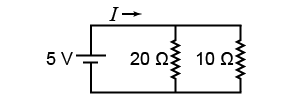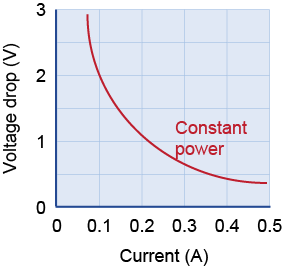- Three resistors, each having a resistance of 25 Ω, are connected in series. What is their effective resistance?
- A hair dryer and a curling iron have resistances of 15 Ω and 25 Ω, respectively, and are connected in series. They are connected to a 60 V battery. Calculate the
- current through the circuit.
- power used by the hair dryer.
- power used by the curling iron.
- A 100 W light bulb is plugged into a 120 V socket.
- How much current is drawn by the light bulb?
- Using your value for the current, determine the value of the bulb’s resistance.
 Three resistors, each having a resistance of 30 Ω, are connected in parallel with each other. What is the value of their effective resistance? Three resistors, each having a resistance of 30 Ω, are connected in parallel with each other. What is the value of their effective resistance?
 A string of 50 identical tree lights connected in series dissipates 100 W when connected to a 120 V power outlet. A string of 50 identical tree lights connected in series dissipates 100 W when connected to a 120 V power outlet.
- What is the equivalent resistance of the string?
- What is the resistance of each individual light?
- How much power is dissipated by each light?
 Suppose that you are experimenting with a 15 V source and two resistors: R1 = 2500 Ω and R2 = 25 Ω. Find the current for a, b, c, and d below. What do you notice? Suppose that you are experimenting with a 15 V source and two resistors: R1 = 2500 Ω and R2 = 25 Ω. Find the current for a, b, c, and d below. What do you notice?
- R1 in series with R2
- R1 in a circuit alone
- R1 in parallel with R2
- R2 in a circuit alone

 Consider the circuit shown. Consider the circuit shown.
- Calculate the effective resistance.
- Calculate the current I.
 A 20 Ω lamp and a 30 Ω lamp are connected in series with a 10 V battery. Calculate the following: A 20 Ω lamp and a 30 Ω lamp are connected in series with a 10 V battery. Calculate the following:
- the equivalent resistance
- the current through the circuit
- the voltage drop across the 20 Ω lamp
- the voltage drop across the 30 Ω lamp
- the power dissipated by the 20 Ω lamp
- the power dissipated by the 30 Ω lamp
| | - A hair dryer and a curling iron have resistances of 15 Ω and 25 Ω, respectively, and are connected in parallel. They are connected to a 60 V battery.
- Calculate the current through the circuit.
- Calculate the power used by the hair dryer.
- Calculate the power used by the curling iron.
 A 20 Ω lamp and a 30 Ω lamp are connected in parallel with a 10 V battery. Calculate the following: A 20 Ω lamp and a 30 Ω lamp are connected in parallel with a 10 V battery. Calculate the following:
- the equivalent resistance
- the current through the circuit
- the voltage drop across the 20 Ω lamp
- the voltage drop across the 30 Ω lamp
- the power dissipated by the 20 Ω lamp
- the power dissipated by the 30 Ω lamp
 A 1,000 W immersion heater, a 700 W microwave oven, and a 1,200 W toaster oven are all plugged into a single 120 V outlet. The outlet is connected to a 15 A circuit breaker. Will the circuit breaker trip? A 1,000 W immersion heater, a 700 W microwave oven, and a 1,200 W toaster oven are all plugged into a single 120 V outlet. The outlet is connected to a 15 A circuit breaker. Will the circuit breaker trip?
 Use Ohm’s law and the equation P = IV to find the power of a simple circuit with a 5 V voltage source and a 2 kΩ resistor. Use Ohm’s law and the equation P = IV to find the power of a simple circuit with a 5 V voltage source and a 2 kΩ resistor.
 You have a 30 V source and two resistors: R1 = 10 Ω and R2 = 25 Ω. Find the current in a circuit with the resistors connected in parallel. What is the current through each resistor if they are connected to the power supply separately? Do you notice anything? You have a 30 V source and two resistors: R1 = 10 Ω and R2 = 25 Ω. Find the current in a circuit with the resistors connected in parallel. What is the current through each resistor if they are connected to the power supply separately? Do you notice anything?
 A voltage divider is a series circuit that is used to produce a specific voltage across one of its resistors. Find a symbolic expression for the voltage V2 across resistor R2 using circuit elements V, R1, and R2. A voltage divider is a series circuit that is used to produce a specific voltage across one of its resistors. Find a symbolic expression for the voltage V2 across resistor R2 using circuit elements V, R1, and R2.

 The voltage versus current graph shows a constant power curve of a resistor R = 20 Ω. The voltage versus current graph shows a constant power curve of a resistor R = 20 Ω.
- What is the operating voltage?
- What is the operating current?
|

